Witness: “It has collapsed. The Morandi Bridge. The one above Polcevera.”
Emergency Phone Operator: “What do you mean collapsed?”
Witness: “It collapsed. How did it collapse? It collapsed. Go ask someone else how it collapsed.”
Emergency Phone Operator: “The one on Via Filliak.”
Witness: “Yes, Yes. Send out the alarm immediately before thousands of cars start falling in.”
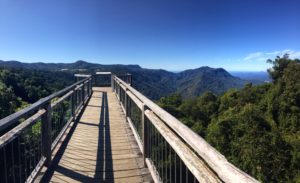 Beginnings and endings happen all of the time. The highs and lows, the sadness and happiness. None of these experiences enjoy perfect timing, and indeed most show up when you are busy beachcombing your bedroom for an odd sock or cell phone. That’s when things seem to happen. Within my own family, I got unexpected word that someone had gotten married. Months early, I’d received notice that someone else was getting divorced. The two are not mutually inclusive, but each event does remind me of how life comes at us in so many different forms regardless of whether we see it coming or not.
Beginnings and endings happen all of the time. The highs and lows, the sadness and happiness. None of these experiences enjoy perfect timing, and indeed most show up when you are busy beachcombing your bedroom for an odd sock or cell phone. That’s when things seem to happen. Within my own family, I got unexpected word that someone had gotten married. Months early, I’d received notice that someone else was getting divorced. The two are not mutually inclusive, but each event does remind me of how life comes at us in so many different forms regardless of whether we see it coming or not.
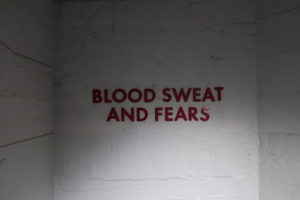 I’ve been thinking about the bridge that recently collapsed in northwest Italy. It’s been a few days since the so-called “absurd” catastrophe, and as the fatality count levels off, national spokesmen point fingers and promise accountability. Meanwhile, news outlets run parallel stories that serve as the beating heart of the tragedy. The world reads about the individual stories of those whose lives were impacted. Nearly 40 people were gone in a matter of moments.
I’ve been thinking about the bridge that recently collapsed in northwest Italy. It’s been a few days since the so-called “absurd” catastrophe, and as the fatality count levels off, national spokesmen point fingers and promise accountability. Meanwhile, news outlets run parallel stories that serve as the beating heart of the tragedy. The world reads about the individual stories of those whose lives were impacted. Nearly 40 people were gone in a matter of moments.
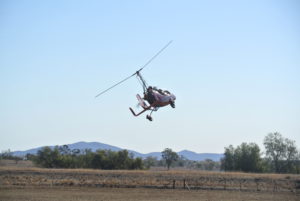 “We know not the day or the hour.” This was the retort of a crusty old Irish professor when asked whether he’d be in his office during a particular time. He was largely kidding, of course, but he had a point. None of us spend much time preoccupied over when we might ultimately bow out of life. Instead, it’s preferable to routinely embark upon activities of varying safety that may or may not leave us in a pile of smashed bits. A simple journey across the Morandi Bridge? That’s hardly a moment to wonder whether you’ll make it to the other side.
“We know not the day or the hour.” This was the retort of a crusty old Irish professor when asked whether he’d be in his office during a particular time. He was largely kidding, of course, but he had a point. None of us spend much time preoccupied over when we might ultimately bow out of life. Instead, it’s preferable to routinely embark upon activities of varying safety that may or may not leave us in a pile of smashed bits. A simple journey across the Morandi Bridge? That’s hardly a moment to wonder whether you’ll make it to the other side.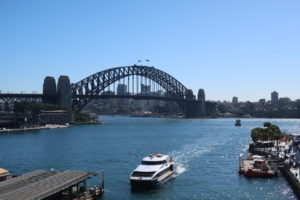 I’m writing this post from Sydney, where I had a few spare hours before my flight back home. The morning sun was shining brightly, and it served as a smiling contrast to the gray and rain that first greeted me two weeks ago. I had initially intended to twist my way through the Royal Botanic Gardens, but after wandering around the fringes of Circular Quay, I caught sight of a metal staircase with a sign suggesting a raised walk toward the Sydney Harbour Bridge. I scrapped my Garden plans and took the stairs.
I’m writing this post from Sydney, where I had a few spare hours before my flight back home. The morning sun was shining brightly, and it served as a smiling contrast to the gray and rain that first greeted me two weeks ago. I had initially intended to twist my way through the Royal Botanic Gardens, but after wandering around the fringes of Circular Quay, I caught sight of a metal staircase with a sign suggesting a raised walk toward the Sydney Harbour Bridge. I scrapped my Garden plans and took the stairs.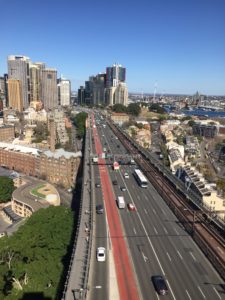 The walkway is a rather loud and unsightly path; this is on account of it running adjacent to the main artery through the city. But as I said, it was a nice day, and I was keen to get a closer view of a structure that is locally referred to as The Coat Hanger. While it is not the same, Sydney’s bridge does bear a resemblance to the ones that bring me back home to Cape Cod. Or maybe it doesn’t. In my mind, I am constantly scanning for parallels of the people and places that I love most.
The walkway is a rather loud and unsightly path; this is on account of it running adjacent to the main artery through the city. But as I said, it was a nice day, and I was keen to get a closer view of a structure that is locally referred to as The Coat Hanger. While it is not the same, Sydney’s bridge does bear a resemblance to the ones that bring me back home to Cape Cod. Or maybe it doesn’t. In my mind, I am constantly scanning for parallels of the people and places that I love most.
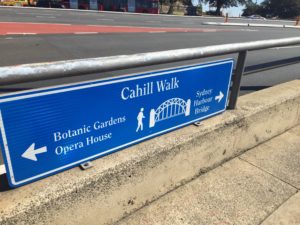 But the Sydney Harbour Bridge is unique in its own right. As I got closer, there was more foot traffic dotting the pedestrian walkway. Where the motorway intersected with the arch, it was hard to take in the massive structure from the bottom. Having done no advance research, I was happy to discover that I could pay to climb one of the pylons in search of a better view.
But the Sydney Harbour Bridge is unique in its own right. As I got closer, there was more foot traffic dotting the pedestrian walkway. Where the motorway intersected with the arch, it was hard to take in the massive structure from the bottom. Having done no advance research, I was happy to discover that I could pay to climb one of the pylons in search of a better view.
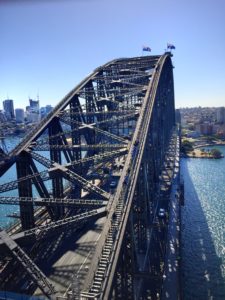 After climbing 200 steps inside the pylon, I was greeted by a brilliant panoramic view of the city. The harbour buzzed with ferries and commercial traffic that carved white swaths through the blue water. I could now able to see the very top of the bridge as well: the two Australian flags flapped proudly while daredevil climbers slowly made their way up and down the span of the arch. These tourists/thrill seekers are clipped in as they complete their climb, but from where I stood atop the pylon, this seemed to border on insanity. I can think of better ways in which I might potentially cash all of my earthly chips in.
After climbing 200 steps inside the pylon, I was greeted by a brilliant panoramic view of the city. The harbour buzzed with ferries and commercial traffic that carved white swaths through the blue water. I could now able to see the very top of the bridge as well: the two Australian flags flapped proudly while daredevil climbers slowly made their way up and down the span of the arch. These tourists/thrill seekers are clipped in as they complete their climb, but from where I stood atop the pylon, this seemed to border on insanity. I can think of better ways in which I might potentially cash all of my earthly chips in.
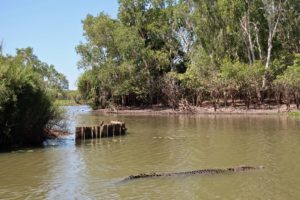 Bridges are attractive for a number of reasons—speaking both practically and figuratively. Bridges unite two pieces of land that previously had their own identity. They might provide safe passage over something dangerous. They connect people and places and thus allow us so much more than what we had while separated. A bridge is possibility.
Bridges are attractive for a number of reasons—speaking both practically and figuratively. Bridges unite two pieces of land that previously had their own identity. They might provide safe passage over something dangerous. They connect people and places and thus allow us so much more than what we had while separated. A bridge is possibility.
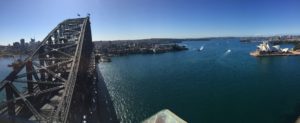 And so of course, I completed my own walk across Sydney Harbour, I thought some more about Genoa and the Morandi Bridge. I remembered reading the testimony of a truck driver who passing underneath and swears he was saved by a miracle wind that blew him back from where the debris fell. I read many other stories and saw photographs that depicted those who received no such miracle.
And so of course, I completed my own walk across Sydney Harbour, I thought some more about Genoa and the Morandi Bridge. I remembered reading the testimony of a truck driver who passing underneath and swears he was saved by a miracle wind that blew him back from where the debris fell. I read many other stories and saw photographs that depicted those who received no such miracle.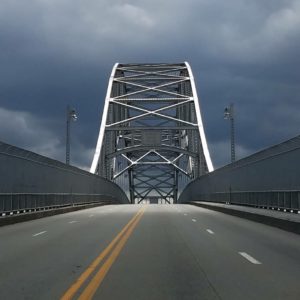 Amidst all of these associative thinking, I found it hard not to bring into mind The Bridge of San Luis Rey. In the story, Brother Juniper witnesses a woven suspension bridge collapse while five people are traversing. In their deaths, the Franciscan monk spends years tracing the lives of these people in an attempt to demonstrate Divine Providence. He strives to show how things are connected, how it is all part of something greater. If 25 million vehicles really do cross the Morandi Bridge each year, it’s a little mind bending to think about how time managed to stop for those 40 souls in a single moment.
Amidst all of these associative thinking, I found it hard not to bring into mind The Bridge of San Luis Rey. In the story, Brother Juniper witnesses a woven suspension bridge collapse while five people are traversing. In their deaths, the Franciscan monk spends years tracing the lives of these people in an attempt to demonstrate Divine Providence. He strives to show how things are connected, how it is all part of something greater. If 25 million vehicles really do cross the Morandi Bridge each year, it’s a little mind bending to think about how time managed to stop for those 40 souls in a single moment.
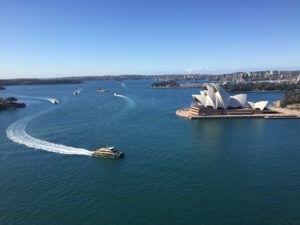 Like all the others, I spent my uneventful morning without once considering the status of my well-being. The cars and public trains that also passed over the Sydney bridge, I doubt that they paused to give it a thought, either. Instead we all just focus on what our next connection is going to be, and how close we were to making it. As for me, I had a plane to catch—and yet, life moves in such a way that we don’t always get to our next point. Sometimes it’s because we drive change, other times it’s because the ground beneath our feet has opened up and we become true passengers. I do not attempt to make light of what happened in Genoa, because my heart truly breaks when I see the photos of smiling humans who undoubtedly spent their final moments in a state of terror. I can’t vouch for God’s great plan, or who might be at fault for potentially a failure in public infrastructure. I can only reflect on the idea of the bridge itself, and the idea of road that is laid in front of us.
Like all the others, I spent my uneventful morning without once considering the status of my well-being. The cars and public trains that also passed over the Sydney bridge, I doubt that they paused to give it a thought, either. Instead we all just focus on what our next connection is going to be, and how close we were to making it. As for me, I had a plane to catch—and yet, life moves in such a way that we don’t always get to our next point. Sometimes it’s because we drive change, other times it’s because the ground beneath our feet has opened up and we become true passengers. I do not attempt to make light of what happened in Genoa, because my heart truly breaks when I see the photos of smiling humans who undoubtedly spent their final moments in a state of terror. I can’t vouch for God’s great plan, or who might be at fault for potentially a failure in public infrastructure. I can only reflect on the idea of the bridge itself, and the idea of road that is laid in front of us.